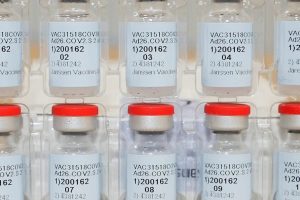FDA authorizes Johnson & Johnson’s one-dose COVID vaccine, doses expected to start rolling next week

The U.S. Food and Drug Administration has authorized a third COVID-19 vaccine for public use.
As expected on Saturday, acting Commissioner Dr. Janet Woodcock granted an emergency use authorization for a vaccine developed by Janssen Pharmaceuticals, a Johnson & Johnson company.
About 4 million doses of the new vaccine should be made available next week, 20 million total during March, and another 80 million by the end of June. Because the vaccine requires only one dose, it will help protect 100 million people and take effect more rapidly than the two-dose vaccines.
The J&J vaccine joins two others: one from Pfizer-BioNTech and the other from Moderna, which have been given to nearly 50 million Americans since they were authorized in December.
Want to hug again? ‘It’s up to you’: New ad campaign gets right to the point on COVID-19 vaccines
An FDA advisory committee voted Friday to support J&J’s vaccine, finding that its benefits far outweighed its risks.
Woodcock agreed.
“The authorization of this vaccine expands the availability of vaccines, the best medical prevention method for COVID-19, to help us in the fight against this pandemic, which has claimed over half a million lives in the United States,” Woodcock said in a statement. “The FDA, through our open and transparent scientific review process, has now authorized three COVID-19 vaccines with the urgency called for during this pandemic, using the agency’s rigorous standards for safety, effectiveness and manufacturing quality needed to support emergency use authorization.”
President Joe Biden in a statement said Saturday’s authorization means “there’s a light at the end of the tunnel” but again stressed the importance of mitigation measures like hand washing and social distancing.
“We know that the more people get vaccinated, the faster we will overcome the virus, get back to our friends and loved ones, and get our economy back on track,” he said.
He added: “This fight is far from over. Though we celebrate today’s news, I urge all Americans — keep washing your hands, stay socially distanced, and keep wearing masks. As I have said many times, things are still likely to get worse again as new variants spread, and the current improvement could reverse.”
Dr. Richard Besser, president and CEO of the Robert Wood Johnson Foundation and former acting director of the Centers for Disease Control and Prevention, applauded the FDA’s decision but cautioned against complacency.
“With three COVID-19 vaccines now available, the number of cases and deaths around the country continuing to fall, and Congress taking steps toward approving additional critically needed economic relief, I have never been more encouraged that we might be finally turning the corner on this pandemic,” he said in a statement.
Besser also said increases in vaccine supply “are welcome but insufficient on their own to end” the racial disparities in vaccine distribution.
“People of color in the United States have suffered a cruel dichotomy: among the highest rates of COVID-19 cases, hospitalizations and deaths, and among the lowest rates of vaccination.”
The Moderna and Pfizer-BioNTech vaccines appear to be more effective than J&J’s vaccine, showing better than 94% effectiveness in large trials they ran last year.
Although the vaccines can’t be compared directly, because the trials were conducted at different times, J&J’s vaccine appeared to be 72% effective among U.S. trial participants. It was less effective in South Africa and Latin America, where newer strains of the virus are circulating.
A side effect of the COVID-19 vaccine can mimic a sign of breast cancer: This is normal, doctors say
The one-shot J&J vaccine also should be easier to distribute to rural areas and other places without pharmaceutical-grade freezers, because it can be stored for longer in a refrigerator.
And it may cause fewer side effects than the other two vaccines, with only about 50% of trial participants reporting injection-site pain compared to nearly 80% for the Pfizer-BioNTech and Moderna vaccines, particularly with second shots.
The company will offer trial participants who received the placebo an active vaccine and will continue to follow them for two years.
The government has several safety monitoring systems to keep track of any health problems connected to the shots.
An advisory committee to the CDC will meet Sunday and Monday to discuss how the J&J vaccine should be used. Dr. Rochelle Walensky, head of the CDC, will then review the vaccine, and it should be ready for distribution early next week.
Contact Karen Weintraub at [email protected]
Health and patient safety coverage at USA TODAY is made possible in part by a grant from the Masimo Foundation for Ethics, Innovation and Competition in Healthcare. The Masimo Foundation does not provide editorial input.
Source: Read Full Article
